An Advanced Guide: Part 1
Thrips are an incredibly cryptic and pervasive group of insects. They belong to the order Thysanoptera, or “fringed-winged,” because of their long and narrow feather-like wings. Measuring less than 2.5 mm in length, these small and slender insects are prevalent pests in greenhouses and grow rooms across Canada. Worldwide there are over 7000 species, coming in a small array of colors from white to yellow and black to brown. They also have a diverse range of ecosystem functions. Some are predators or harmless pollen and fungal feeders, but the most notable are those found feeding on plants. These, 25 or so species, are some of the most devastating plant pests in agriculture.
The most well-prominently found thrips in Canadian greenhouses and indoor grow facilities are:
- Western Flower Thrips (Frankliniella occidentalis)
- Onion Thrips (Thrips tabaci)
- Poinsettia Thrips (Echinothrips americanus).
Less commonly found species include:
- Greenhouse Thrips (Heliothrips haemorrhoidalis)
- Pepper Thrips (Thrips parvispinus)
- Rose Thrips (Thrips fuscipennis)
- European flower thrips (Frankliniella intonsa)
- Chili thrips (Scirtothrips dorsalis).
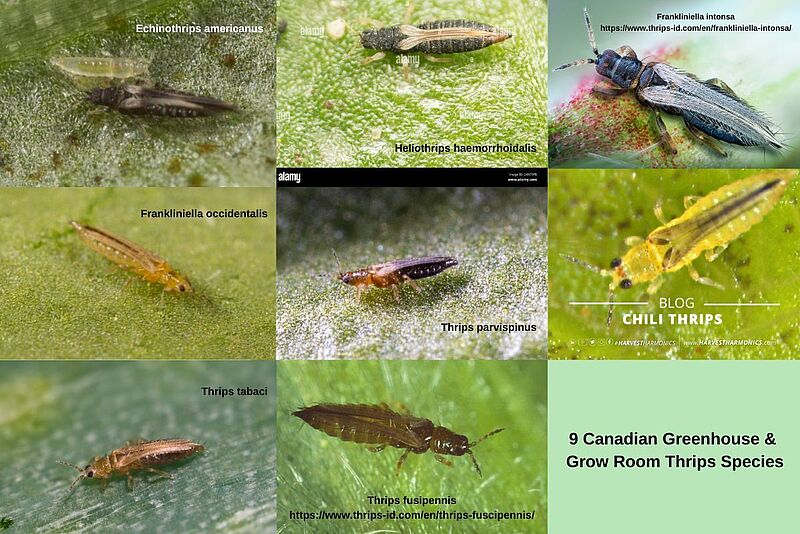
Thrips damage foliage, flowers, and fruit directly with their piercing mouthparts and saw-like ovipositor as well as causing indirect damage via vector of plant viruses. While it is difficult to reliably estimate how much this costs Canadian growers, it is at least likely in the hundreds of millions of dollars annually. This kind of damage potential requires growers to be vigilant regarding thrips control.
The three largest challenges in thrips management are:
(1) Ability to rapidly develop resistance to common pesticides
(2) Broad host plant range
(3) Their minuscule and segregated life stages
In this comprehensive overview, we will discuss the thrips lifecycle, ecologies, and a little bit about each species mentioned above. Like any pest or disease, understanding their biology and behavior is key to strong and effective management.
How have these thrips species become so globalized?
Several of the most harmful thrips species in Canada have traveled far outside of their native ranges. Some originate from places like the Mediterranean and Asia.
Part of what makes these insects so invasive is:
- Global trade and transit of plant materials
- The cryptic nature of thrips
- Their ability to readily adapt to new environments
Over the last 100 years, global trade has accelerated at an unprecedented pace. Economies and industries have benefited from increased access to resources, materials, and products; however, these goods can bear stowaways. Many of these invasive species have considerable economic and environmental impact, especially thrips.
As thrips are small, they can easily conceal themselves in crop canopies and soil debris, making them very hard to detect in transported materials. Once they’ve made it to their destination, their short life span, reproductive capacity, and generalist diet allow them to establish in new crops, greenhouses, and regions rapidly. This has created new populations and new sources of infestation and crop loss around the world.
How do thrips typically enter Greenhouse and Indoor growing spaces?
There are three primary avenues thrips can enter a crop in sufficient numbers causing an immediate issue:
- Imported cutting material
- Dormant pupae left on the floor from prior crops
- Wind; through vents, from neighboring habitats or crops
*Thrips can also be carried into facilities on staff clothing/hair and in growing media through dormant pupae form (these are more inoculation events, rarely carrying significant numbers to create an immediate outbreak).
Imported Cutting Material - Cuttings and starter plants can carry exotic and invasive thrips species into new environments. Even diligent propagators and suppliers can miss thrips and pass them along to other growers and clients, often invisibly in the form of eggs deposited in leaf or flower tissue. This is especially evident in tropical and exotic ornamentals where plant material is often moved between countries and regions rapidly spreading novel or exotic thrips species worldwide. This also becomes an issue in many cases as certain pesticide resistance might have built up in these propagator populations, and clients are left to combat these chemically resistant thrips. If not handled properly, this propagation material can become a substantial source point of thrips that can quickly establish and damage crops.
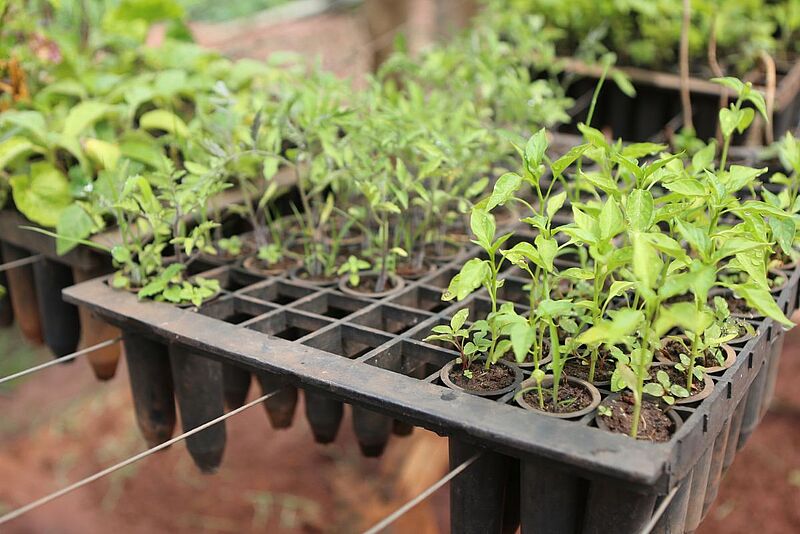
Pupae - Thrips issues often emerge from pupae carried over from past crops on the floor or in reused growing media. The pupae stage of thrips is a dormant phase designed to carry the population through winter or in other undesirable climatic conditions. Pupae can sit for many months in cool greenhouses or grow rooms waiting for fresh crops and increased temperatures to hatch out and establish. This is a very common issue as growers are either unaware of the potential of large amounts of dormant pupae being carried unseen between crops or underestimate their ability to resist clean-up treatments. As the pest is dormant and protected in the hard pupal casing it is extremely resistant to pesticide treatments.

Vents - The other way that thrips enter a crop, and arguably the most common, is by flying into the greenhouse from surrounding environments or adjoining crops. While thrips are not strong fliers, they can easily be picked up by air currents and wind getting sucked into wind-facing or inlet vents. Most facilities have a constant low-level influx of thrips via vents often with extreme peaks as outside crops are harvested or dry up sending large amounts of thrips airborne in search of a new home.

Thrips Identification
A formal thrips identification is a great first step in understanding what integrated pest management program will be the most effective for your crop and conditions—size and color will be the first point of identification.
With a 10x hand lens, a great place to start can be observing the adults and determining if the thrips are light-colored or dark-colored. Larva color, movement, behavior, damage, and how the population is distributed on the plant are also important clues as to what species a grower may be working with.
Certain Thrips are complicated to properly identify so in situations like this samples can be sent to a laboratory for morphological or genetic testing with results being returned in about 1-3 weeks. However, there are also great resources out there to attempt an in-house identification.
For a full key on how to identify Canadian thrips, click here > (Key-to-important-thrips-pests-of-Ontario-greenhouses_3rdEd_2022_Final_MR.pdf (greenhouseipm.org))
Physical Damage
All agriculturally significant thrips leave a very similar type of damage, regardless of the crop they inhabit. This characteristic feeding damage is caused by their piercing and sucking mouthparts which they use to puncture plant tissues and suck out cell contents. Without chlorophyll, the cell and its neighbors die. This causes the characteristic silver stippling that will aggregate as small silver striations or lesions, often peppered in dark spots of frass. This damage can be found on petals and the leaves.
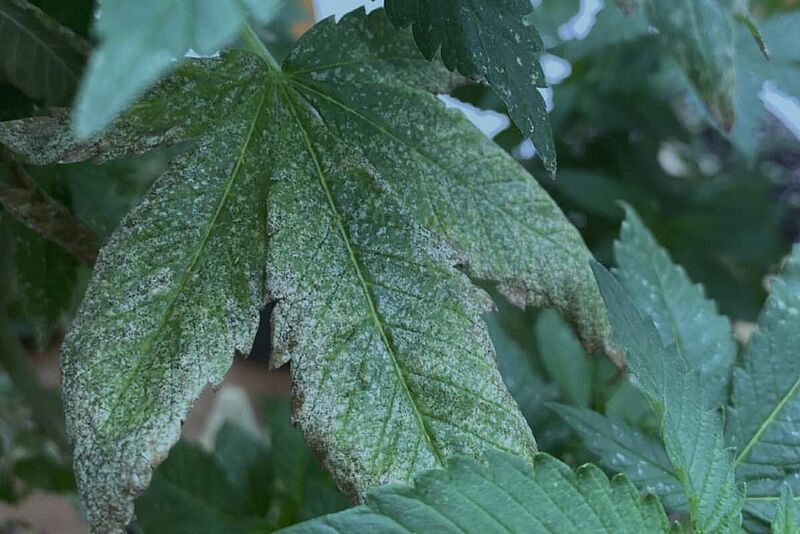
Thrips can also distort new tissue. Adults will often move to and lay their eggs in new emerging vegetative and floral growth tips. This small egg-laying and feeding damage translates into disfigured tissues which become more apparent as they develop, often not being noticed until days or weeks after the damage has been done. This loss in photosynthesis has been linked to a significant loss in crop yield. When infestations are at high levels, plants can begin losing leaves, flowers, and fruits.
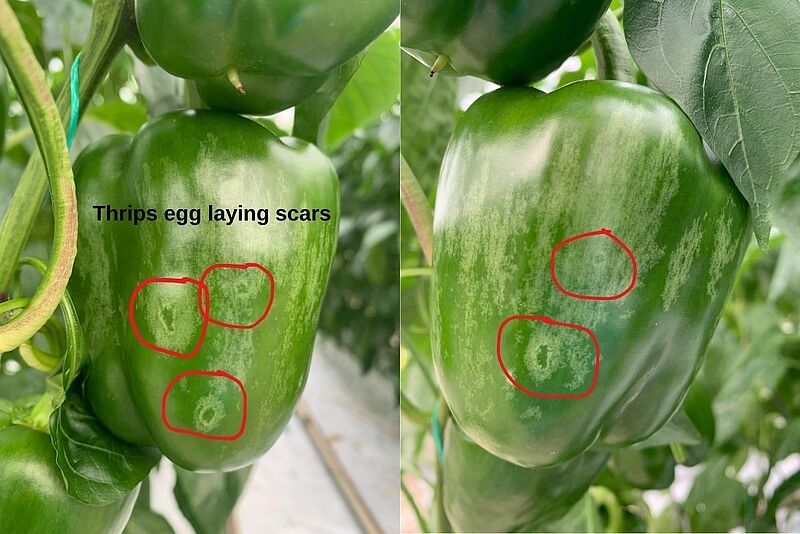
Depending on the type of thrips, damage can be distinct or concentrated in a particular area of the plant. For example, Western flower thrips (Frankliniella occidentalis) will likely cause more damage to flowers and new shoots. In contrast, Poinsettia thrips (Echinothrips americanus) often concentrate their damage in older vegetative tissues, lower in the canopy.
Thrips can also cause other forms of damage indirectly as viral vectors or, in some cases, as carriers of fungi and bacteria.
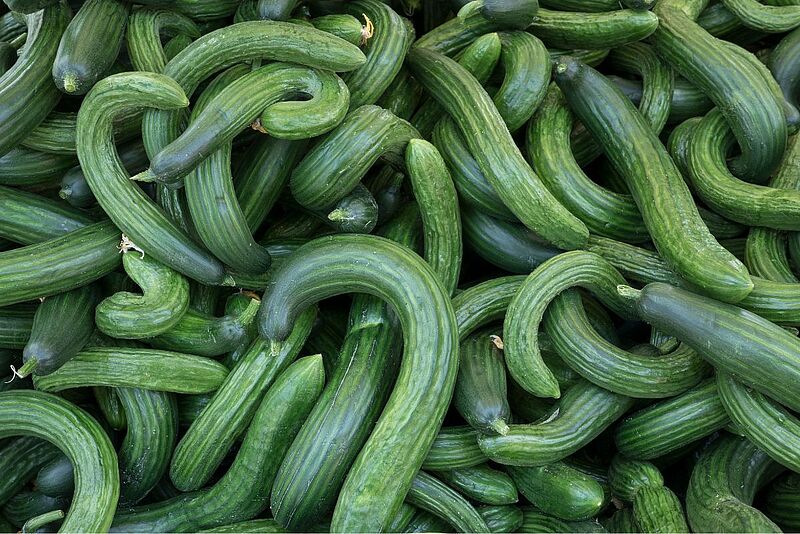
Viral Vectoring
Thrips can cause significant damage to plants indirectly by transmitting viruses. About 64% of known plant viruses are transmitted by insects like aphids, whiteflies, and thrips.
All viral insect vectors share similar mouth apparatus’: stylets, or needle-like mouth parts. Puncturing the tissue and sucking out vital fluids from the phloem and xylem, exposes insect tissues to viruses and viroids. Depending on the virus, they can persist for seconds, days, months, or indefinitely.
To date, 16 thrips species are reported to transmit more than 29 Tospoviruses worldwide. In North America, there are 9 Tospoviruses all primarily transmitted by Frankliniella spp.:
- Tomato Spotted Wilt Virus (TSWV)
- Tomato Chlorotic Spot Virus (TCSV)
- Groundnut Ring-Spot Virus (GRSV)
- Pepper Necrotic Spot Virus (PNSV)
- Alstroemeria Necrotic Spot Virus (AINSV)
- Zucchini Lethal Chlorosis Virus (ZLCV)
- Impatiens Necrotic Spot Virus (INSV)
- Chrysanthemum Stem Necrotic Virus (CSNV)
- Melon Severe Mosaic Virus (MSMV).
Reproduction
Thrips can reproduce both sexually and asexually. Fertilized females lay both male and female eggs whereas unfertilized females will lay only male eggs (this can differ between species and even regional groups of the same species). Thus, giving thrips, a variety of strategies to adapt and quickly expand their populations without relying on sexual reproduction. As a result, even a single individual can trigger a significant infestation.
Life Cycle of Thrips
Thrips have six life stages: egg, two nymphal instars, a pre-pupa stage, a pupal stage, and an adult.
The kidney-shaped egg is laid in soft plant tissues: young leaves, petals, and soft veins or stalks. In most crops, the egg scars are impossible to see with the naked eye, but in crops like sweet pepper, they can appear as small pinpricks. Once hatched the small cigar-shaped larva will immediately begin to feed. Each species will have preferences in how they disperse along the plant.
When wing buds begin to develop, the larva begins to mature into their immobile prepupal stage. As the wing buds lengthen the antennae will curve back over the head as the thrips enter the pupal stage. Pre-pupa and pupa, for most economically important species, drop to the floor or soil to develop. The notable exception to this rule is Echinothrips americanus, whose pupae remain on the plant. When pupae do fall, they can either lay on the soil surface or embed themselves as far as 15mm deep. Thrips do not feed during this stage and only move when disturbed.
Once they emerge, young adults will return to the plant searching for food, mates, and oviposition sites.
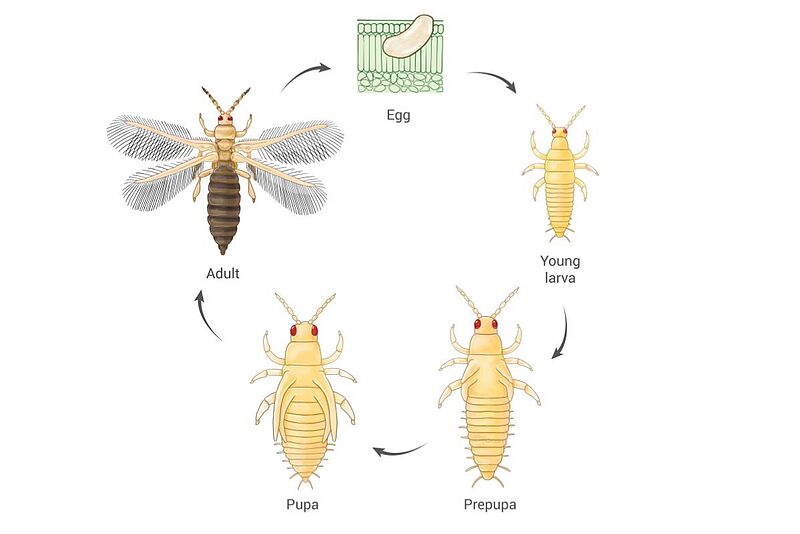
Temperature and Development
Environmental factors play a huge role in the development and establishment of thrips. Depending on temperature, humidity, and crop development times can vary. It takes the average Western flower thrips (Frankliniella occidentalis) nine days to develop from egg to adult at 30°C, whereas it will take almost 40 days at 15°C. Above 35° C and below 10° C, development ceases. Generally, all economically important thrips have similar development times, some exotic species simply have a harder time developing at all below 15°C and die if exposed to cooler temperatures for an extended period.
Pollen availability can also play a big role in development. Thrips develop much faster on plants that produce pollen than on plants that don’t have pollen or flowers.
Overwintering
Some species of thrips can survive the winter outside as adults. They are often migrating to different host species like weeds, to shelter for the winter. This has been observed both inside and outside heated growing spaces. Some species have been shown to overwinter as eggs or larvae. This behavior is triggered by changes in day length but ultimately temperatures will be the biggest factor in whether thrips remain active, overwinter successfully, or die.
List of Main Pest Thrips Species in Canada
Western Flower Thrips
Species Name: Frankliniella occidentalis
Common Name: Western Flower Thrips
Crops: over 250 species (2009)
Country of Origin: North America, West
Global Distribution: Global
Overview: Western Flower Thrips originate from the west coast of North America and have spread globally over the last 30 years. They are a major pest in greenhouses around the world and are the most common thrips found in Canadian greenhouses. As their name suggests, they are often found on flowers but also on the underside of leaves. In addition to pollen and plant tissues, Western Flower Thrips have been shown to eat the eggs of two-spotted spider mites and the first larval instar of greenhouse whitefly. Western Flower Thrips are also known for their ability to rapidly develop pesticide resistance.
This medium-sized species, 1.0-1.2 mm long, can vary from yellow to brown depending on the environment and season. They have red ocelli, and long wings compared to other thrips species.Larvae are small, cigar-shaped, and yellow. Once they are large enough, they will fall to the ground to pupate. They can overwinter in temperate regions.
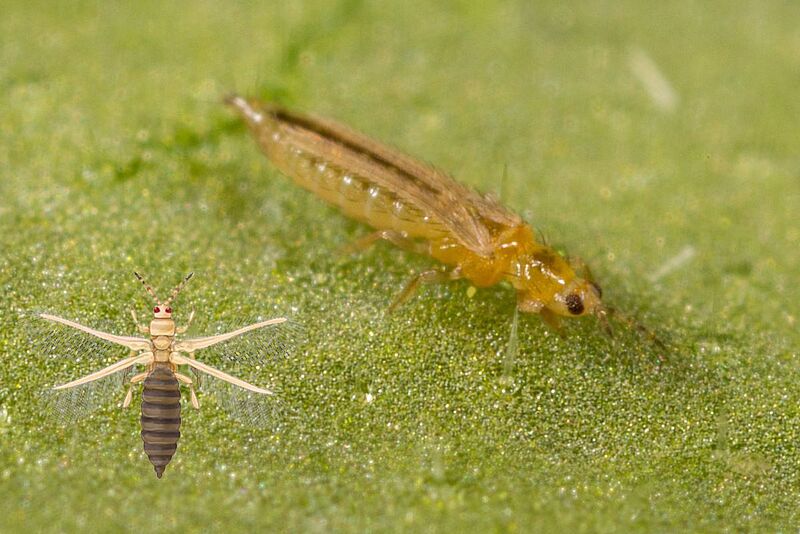
Onion Thrips
Species Name: Thrips tabaci
Common Name: Onion Thrips
Crops: Over 391 plant species (2022)
Country of Origin: Mediterranean.
Global Distribution: Global
Overview: Onion thrips were the most common and devastating thrips species until the 1970s-80s and remain a key pest today. They have an incredible distribution in greenhouses worldwide and are also known as a major field pest for vegetables and ornamentals. Compared to Western Flower Thrips, they are more sensitive to insecticides and often become the prominent thrips in crops where chemicals are used less. However, they still have a formidable capacity to develop pesticide resistance.
Onion thrips are about the same size as Western Flower Thrips, with adults measuring between 0.8 and 1.2mm long. They have long wings compared to other thrips species and are highly dispersive. They can be carried easily by wind from fields to greenhouses and vice versa. They can be found on the underside of leaves in the top of the crop canopy, and rarely in the flowers. Their color varies from beige and yellow to dark brown, making them difficult to identify by color alone. Their ocelli are grey and often appear like a small bruise between their two compound eyes. As larvae, they are bright yellow and fall into the soil to pupate. In temperate regions, this species can overwinter.
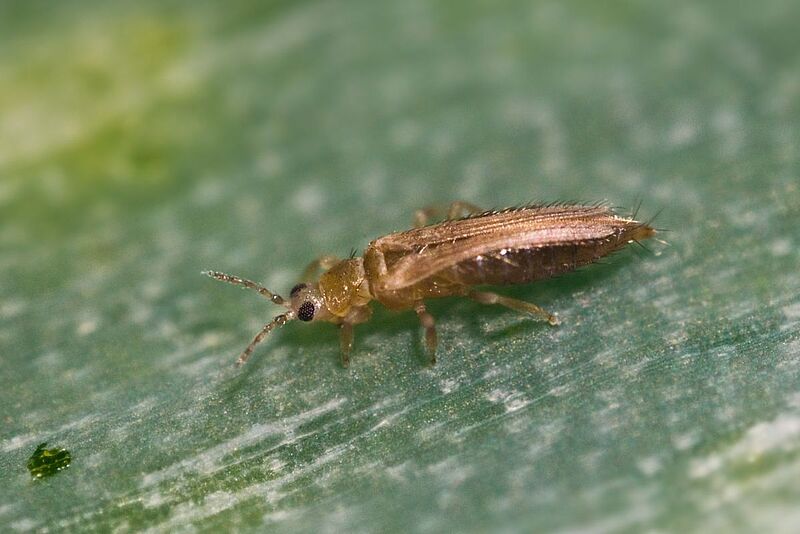
Echinothrips
Species Name: Echinothrips americanus
Common Name: Poinsettia Thrips
Country of Origin: Eastern United States
Global Distribution: Global
Crops: Plants belonging to over 48 families (2014).
Overview: Echinothrips, also known as poinsettia thrips, are a slightly larger species of thrips (1.3-1.6mm). They are brown to nearly black with characteristic red bands between their abdominal segments. Larvae and pupae are clear in color and, unlike other species that drop to the ground, these stages remain on the leaf.
They are relatively sedentary and slow-moving, remaining on the same leaf for days if left undisturbed. Their slow-moving and sedentary lifestyle presents few opportunities for adults to be caught on sticky cards. This can make them a difficult pest to monitor, often not being noticed before infestations reach serious proportions.
As populations grow, the infestation will extend into other parts of the canopy. While they prefer foliage, high enough populations will eventually damage fruits and flowers if left unchecked. Although they can persist within a heated greenhouse year-round on crops and weeds, they can only develop within a narrow range of temperatures, between 20°C and 30°C.
Their damage is also distinct. The stippling can appear more like spider mite damage. As they are larger and hard to reach with sprays in dense canopies there are significant concerns around pesticide resistance and what controls might be the most effective.
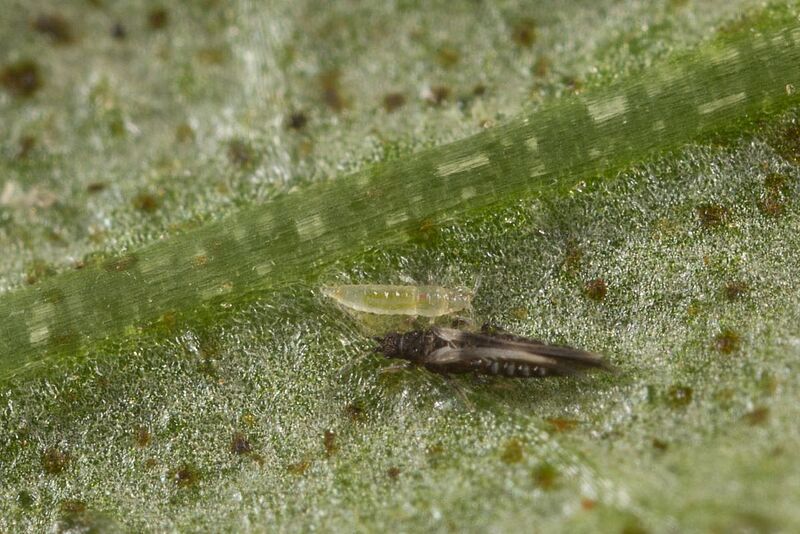
Greenhouse Thrips
Species Name: Heliothrips haemorrhoidalis
Common Name: Greenhouse Thrips
Crops: citrus, avocados, and ornamentals, especially crotons
Country of Origin: worldwide in tropical and sub-tropical regions
Global Distribution: Global
Overview: This thrips species originated from South America and over time, has spread worldwide by the movement of ornamental plants, living in warm greenhouses. It is not believed to over-winter in colder climates.
To identify these thrips, the main thing to look for in the adults is their light-yellow legs and their black-darkish brown coloring. The adults are poor fliers and tend to remain in shaded areas on the plant. The early larval stage is whiteish with red eyes. After feeding, they become a yellowish color. A mature larvae will be around 1mm in length. When the larvae pupate, the antennae will be bent backward over the head. The prepupal and pupal stages do not feed.
This thrips species damages plants differently than others. It will cause blemishes to the tough outer skin of citrus fruit. These blemishes will consist of ring spotting or irregular russeting. On ornamentals, it primarily feeds on the foliage, attacking the lower surface first. When the population increases and feeding progresses, they will move to the upper surface of the plants. Damage to the leaf will consist of distortion between the lateral veins, and discoloration of the leaf will begin to develop, and eventually, the leaves will turn yellow and drop. A characteristic globule droplet will begin to show on the plants as the thrips feed, it is a larger fecal matter droplet than most thrips release.
Photo Taken from greenhouse thrips - Heliothrips haemorrhoidalis (Bouché) (ufl.edu)
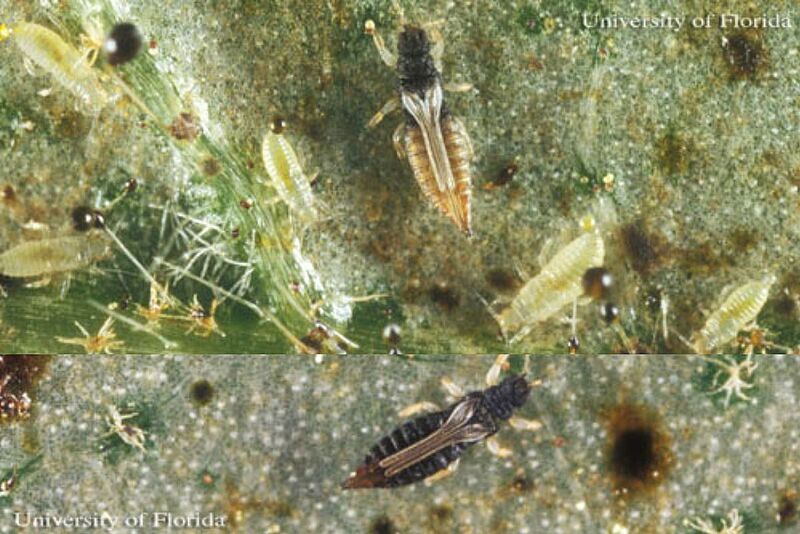
Pepper Thrips
Species Name: Thrips parvispinus
Common Name: Pepper thrips
Crops: Chilli pepper, sweet pepper, Gardenia, green bean, potato, strawberry, citrus, Ficus, gerbera, corn, cotton, onion and marigold, chrysanthemum, anthurium, hoya, hibiscus, ixora, Mandavilla, Schefflera, etc.
Country of Origin: Southeast Asia
Global Distribution: Australia, India, Europe, Africa, China, USA, Central America and Canada
Overview: Pepper thrips are an invasive species of thrips that have emerged out of South Asia. In recent years it has become an up-and-coming pest in North America appearing in places like Hawaii in the early 2000s, Florida in 2020, and Canada in 2021. They are feared for their pesticide resistance and their ability to develop rapidly in a crop. There is also a question of control, as many North American growers have no experience when it comes to controlling this tropical thrips species.
They are most attracted to flowers and growth tips in the plant, leaving damage that resembles that of broad mites. Their feeding and oviposition damage can also leave significant scarring on fruits, foliage, and flowers. So far it is thought that they cannot overwinter in Canadian climates, but instead come into the greenhouse from cuttings and other imported plant materials.
This species is dimorphic, meaning that the females and males look distinct from one another. Adult males are smaller, ~0.8mm, and a lighter yellow than the females. Females are larger, around 1.1mm in length, slender, and two-toned: bearing a light brown head and thorax with a dark brown abdomen. They have red ocelli and, in some cases, have been documented as being particularly agile and mobile. Population growth is fast and robust which makes them difficult to control, especially if they are not caught early.
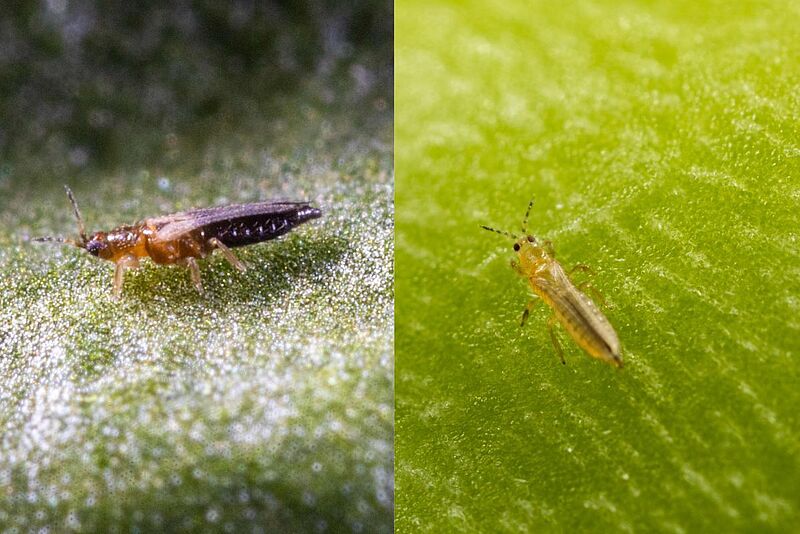
Rose Thrips
Species Name: Thrips fuscipennis
Common Name: Rose Thrips
Crops: Rosaceae family, mainly Roses + legumes and cucumber, over 200+ species of plants
Country of Origin: Europe
Global Distribution: Worldwide, not common in North America
Overview: This thrips species has a very similar appearance to the Onion Thrips and can only be distinguished with a microscope. If you believe you have these thrips, it is suggested to send them off for proper ID.
They are more prevalent in hot, dry conditions. Flowers will become flecked with light spots and streaks; leaves will develop the common silver flecking.
Overwintering in Europe occurs on tree trunks in bark crevices or among young leaves and flower petals in glass greenhouses. Overwintering females are not dormant, and they can move or fly if conditions deteriorate. Pupa drops to the ground and pupate where they land including in the soil.
Has been ID’d in BC greenhouse strawberries, damaging fruit, flowers, and leaves.
Photo taken from Thrips fuscipennis – Thrips-ID English
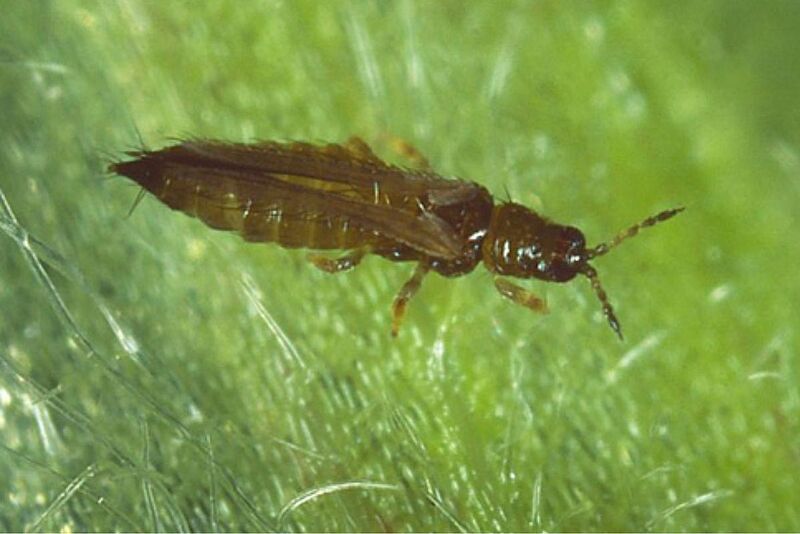
European Flower Thrips
Species Name: Frankliniella intonsa
Common Name: European Flower Thrips
Crops: Strawberries + other wildflowers
Country of Origin: Eurasia
Global Distribution: Worldwide
Overview: Adults measure 2mm in size and are brown with yellow abdominal segments. Field identification is difficult to achieve. For proper identification, this thrips species should be sent off to be ID’d.
Common in BC strawberry greenhouses, damaging fruits, leaves, and flowers. They oviposit their eggs on or within the fruit and can be found in flowering organs. White or blue traps are the most effective for this thrips species.
They do overwinter in Canada, females emerge early in the season mostly from uncultivated areas, establish quickly in strawberry crops, and can be present until late in the season (Canovas, Guay, Fournier, and Cloutier 2023). Has developed resistance to some pesticides, so it is more difficult to control and is known as a vector of Tospoviruses, even though its transmission efficacy is lower than the Western Flower Thrips.
Photo taken from Frankliniella intonsa – Thrips-ID English
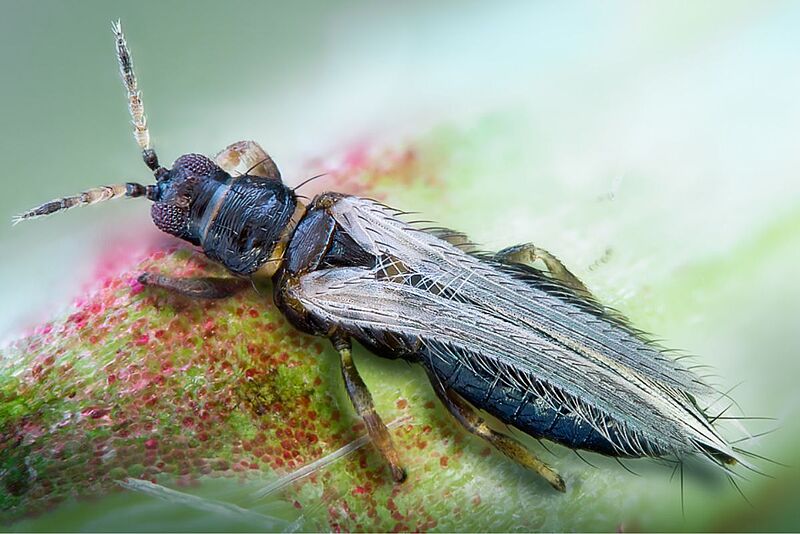
Chili Thrips
Species Name: Scirtothrips dorsalis
Common Name: Chili Thrips
Crops: over 100 + plant varieties including ornamentals, chili peppers, other vegetable crops, etc.
Country of Origin: either in Southeast Asia or the Indian subcontinent
Global Distribution: Worldwide
Overview: The adults are 1.2mm in size, very small compared to other thrips species like Western Flower Thrips, making them more difficult to spot. All life stages occur directly on the plant. Pale in color with dark wings, and dark spots forming incomplete stripes which appear dorsally (on the back of) the abdomen.
This thrips species damages plants by creating damage-feeding scars, distortion of the leaves (rolling of the leaf upward and leaf size reduction), and discolorations to the plant's buds, flowers, and young fruit. It feeds on the meristems of the plant's terminals and other tender parts of the plant above the surface. Damage sometimes resembles Broad Mite damage. If you have a severe infestation, you will notice complete defoliation on affected plants and could have a total crop loss.
To top all this, it is known to possess strong infectious behavior for seven recorded viruses: Chilli Leaf Curl (CLC), Peanut Necrosis Virus (PBNV) (Mound and Palmer 1981, Ananthakrishnan 1993), Tobacco Streak Virus (TSV), Melon Yellow Spot Virus (MYSV), Watermelon Silver Mottle Virus (WsMoV), and Capsicum Chlorosis Virus (CaCV) (Chiemsombat et al. 2008).
Photo taken from Lyle J. Buss, University of Florida
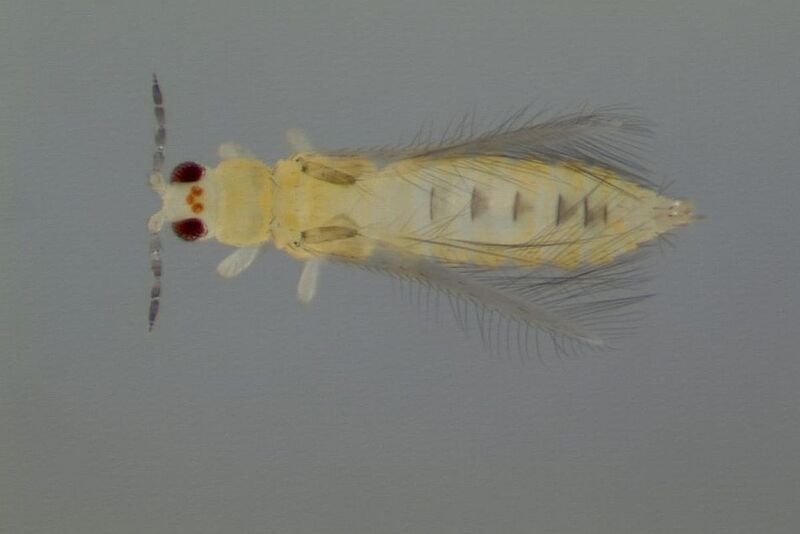
This is just the beginning of the amount of information that can be written about greenhouse and grow room thrips. We have written other articles these last few years, on how to use biological control against this pest species. For more information on this, read these articles here:
- Get Rid of Thrips Naturally Using Predator Mites! | Koppert Canada
- Using Predatory Mites, but still having Thrips Issues? Close the Gap in your Thrips Control Program | Koppert Canada
- Understanding Orius | Koppert Canada
However, this is just part 1. More thrips information will be on its way soon. Stay tuned.